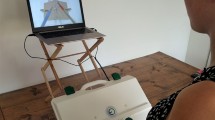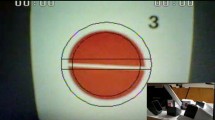Abstract
Purpose
Assessing construct, face and content validity of the camera handling trainer (CHT), a novel low-fidelity training device for 30° laparoscope navigation skills.
Methods
We developed a custom-designed box trainer with clinically based graphic targets. A total of 117 participants, stratified according to their previous experience (novice, competent, expert), took part to a CHT session and subsequently were asked to fill out a survey to assess the impact of the CHT on their 30° laparoscope navigation skills. Sixty of them were also studied for task performance during a 1-h session, with multiple time measurements.
Results
All participants, regardless of the previous experience, significantly improved their performance after the CHT session. Regarding construct validity, the mean task performance on the last measurement for novice group was found to be comparable to the mean first attempt of both competent (p = 0.12) and expert (p = 0.24) participants. All participants agreed that “the CHT is a valid training tool” and that “the CHT should be part of the regular dry laboratory training sessions”, assessing both face and content validity. Limitations include the need for assessment of predictive validity.
Conclusions
The CHT is a valid training tool for 30° laparoscope navigation and thus should be considered as one of the fundamental exercises during basic laparoscopic hands-on training sessions for urologists.


Similar content being viewed by others
References
Franzeck FM, Rosenthal R, Muller KM, Nocito A, Wittich F, Maurus C et al (2012) Prospective randomized controlled trial of simulator-based versus traditional in-surgery laparoscopic camera navigation training. Surg Endosc 26:235–241
Fitts PM, Posner MI (1967) Human performance. Brooks Cole, Belmont
Stefanidis D, Haluck R, Pham T, Dunne B, Reinke T, Markley S et al (2007) Construct and face validity and task workload for laparoscopic camera navigation: virtual reality versus video trainer systems at the SAGES Learning Center. Surg Endosc 21:1158–1164
Korndorffer R, Hayes DJ, Dunne JB, Sierra R, Touchard CL, Markert RJ et al (2005) Development and transferability of a cost-effective laparoscopic camera navigation simulator. Surg Endosc 19:161–167
Brinkman WM, Tjiam IM, Schout BMA, Muijtjens AMM, Van Cleynenbreugel B, Koldewijn EL et al (2014) Results of the European basic laparoscopic urological skills examination. Eur Urol 65:490–496
Buzink SN, Botden SMBI, Heemskerk J, Goossens RHM, de Ridder H, Jakimowicz JJ (2009) Camera navigation and tissue manipulation; are those laparoscopic skills related? Surg Endosc 23:750–757
Yee KA, Karmali S, Sherman V (2009) Validation of a simple camera navigation trainer. J Am Coll Surg 209:6
McDougall EM (2007) Validation of surgical simulators. J Endourol 21(3):244–247
Dreyfus HL, Dreyfus SE (1986) Mind over machine: the power of human intuition and expertise in the era of the computer. The Free Press, New York
Buzink SN, Goossens RHM, de Ridder H, Jakimowicz JJ (2010) Training of basic laparoscopy skills on SimSurgery SEP. Minim Invasive Ther 19:35–41
Ahmed K, Jawad M, Abboudi M, Gavazzi A, Darzi A, Athanasiou T et al (2011) Effectiveness of procedural simulation in urology: a systematic review. J Urol 186:26–34
Shetty S, Panait L, Baranoski J, Dudrick SJ, Bell RL, Roberts KE et al (2012) Construct and face validity of a virtual reality–based camera navigation curriculum. J Surg Res 177:191–195
Wignall GR, Denstedt JD, Preminger GM, Cadeddu JA, Pearle MS, Sweet RM et al (2008) Surgical simulation: a urological perspective. J Urol 179:1690–1699
Andreatta PB, Woodrum DT, Birkmeyer JD, Yellamanchilli RK, Doherty GM, Gauger PG et al (2006) Laparoscopic skills are improved with LapMentor training: results of a randomized, double-blinded study. Ann Surg 243:854–860
Ganai S, Donroe JA, Louis MRS, Lewis GM, Seymour NE (2007) Virtual-reality training improves angled telescope skills in novice laparoscopists. Am J Surg 193:260–265
Acknowledgments
Thanks to Olympus Europe and to the ESU training research group for the kind support offered during the study. Thanks to the “Studio Cassone” in Reggio Calabria for the spaces offered during development phases.
Authors contribution
Domenico Veneziano: protocol/project development and manuscript writing/editing; Andrea Minervini: manuscript editing; John Beatty: data collection or management; Paolo Fornara: data collection or management; Ali Gozen: data collection or management; Francesco Greco: data collection or management; J. F. Langenhuijsen: data collection or management; Luca Lunelli: data collection or management; Deirdre Overgaauw: data collection or management; Jens Rassweiler: manuscript editing; Bernardo Rocco: data analysis; Rafael Sanchez Salas: data collection or management; Shahrokh Shariat: data collection or management; Robert M. Sweet: manuscript editing; Giuseppe Simone: data analysis; Christopher Springer: data collection or management; Agostino Tuccio: data collection or management; Ben Van Cleynenbreugel: manuscript editing; Peter Weibl: data collection or management and Pietro Cozzupoli: manuscript editing.
Author information
Authors and Affiliations
Corresponding author
Ethics declarations
Conflict of interest
The authors declare that they have no conflict of interest.
Ethical standards
The manuscript does not contain clinical studies or patient data.
Rights and permissions
About this article
Cite this article
Veneziano, D., Minervini, A., Beatty, J. et al. Construct, content and face validity of the camera handling trainer (CHT): a new E-BLUS training task for 30° laparoscope navigation skills. World J Urol 34, 479–484 (2016). https://doi.org/10.1007/s00345-015-1657-6
Received:
Accepted:
Published:
Issue Date:
DOI: https://doi.org/10.1007/s00345-015-1657-6




